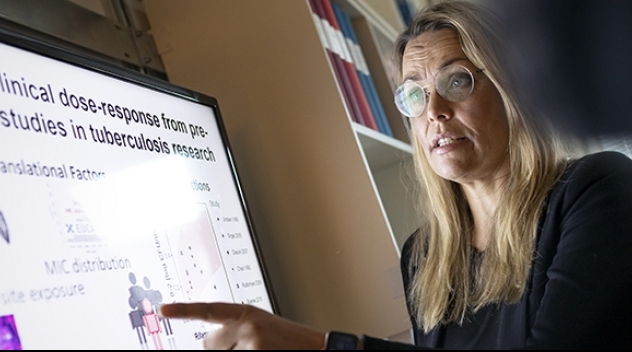Ulrika Simonsson: Building mathematical bridges from drug labs to treatment
Researcher profile
Not even frontline pharmacists have a full overview of the long and winding road from new substance to finished pill. If the medicine is also to accomplish its task in a sick body, an extra map is required. With digits and self-learning machines, Ulrika Simonsson, Professor of Pharmacokinetics, shows the way to more effective drug development and treatments.
To develop a drug from idea to treatment requires both resources and patience. Of the many millions of substances that researchers test, only a few make it through the long and demanding path of trials. And if a drug really passes the eye of the authorities’ needle, a new challenge awaits: To optimise the outcome of individual treatments. The pitfalls are innumerable, but with mathematical models that calculate the right direction for the next step, Ulrika Simonsson, Professor of Pharmacokinetics, creates compasses that reduce the risk of wrong turns.
“Research environments often focus on either preclinical or clinical phases during the development of pharmaceutical drugs. Between the two, there is a relatively deep gap, but by compiling and integrating data from all levels, we create a basis for long-term strategies and more efficiently designed studies, which in turn generate a stronger chain from laboratory to care. Our tools are innovative technologies that we develop in close collaboration with partners from around the world, and it is inspiring to see how our contributions really make a difference.”
Ulrika Simonsson enrolled at Uppsala University as a pharmacy student in the early 90s. Over the years, she has made numerous long-distance excursions in the world of pharmaceuticals: Malaria research in Southeast Asia, clinical studies in Africa, a postdoc in Silicon Valley, two years at AstraZeneca R&D in Gothenburg. But every time she has returned to Uppsala and the Faculty of Pharmacy. Her extensive experience of international pharmacy and industrial conditions is today transformed into a research environment where each member works with perspectives that reach far beyond the borders of both Sweden and the academy.
“My years in the industry and the financial framework that governs their operations are very useful in our current work. Today, we assist a number of companies with their scientific challenges and on their terms, while we remain free to put on our academic spectacles whenever necessary. This flexibility makes us attractive in both interdisciplinary and international contexts, and we were recently selected as the only research group to participate in both the European knowledge consortium ERA4TB and the linear billion investment UNITE4TB,” says Ulrika Simonsson.
The two initiatives bring together more than 60 leading universities and pharmaceutical companies with the aim to develop new tools for effective antibiotic therapies against tuberculosis, the infectious disease which, with increasing antimicrobial resistance, once again constitutes a global threat. Every year, 1.5 million people die as a result of resistant tuberculosis bacteria, a mortality rate that has led many countries to accept the severe side effects that healthcare attempts at combination treatments might cause.
“Since the 1960s, only three new drugs have been developed against tuberculosis, which is far from sufficient. With UNITE4TB, we are receiving EUR 185 million over seven years to develop phase 2 clinical trials in order to accelerate the development of new antibiotics and dose recommendations. Our team is providing the formulations of mathematical models to design these clinical studies and to calculate the outcome. Thus, we are currently enhancing our expertise in artificial intelligence and machine learning, two disciplines that will be future key success factors in our field of science.”
Where traditional tools require increased resources as the amount of data grows, self-learning machines manage to use each new input to refine their capabilities. The more extensive the studies, the greater the possibilities, a fascinating perspective that is already generating new ideas at Lab Simonsson.
“We are currently planning an app where doctors, by entering individual patient data, receive optimal dosage for drug treatments. Here we are exploring strictly regulated domains, but the idea is intriguing and we are in talks with innovation companies about the possibilities to develop a product for the market. What we know for sure is that AI already has great impact in other fields, and that we are facing opportunities to open completely new doors within quantitative pharmacology.”
Magnus Alsne
Facts: Ulrika Simonsson
- Profession Professor of Pharmacokinetics, Uppsala University
- Research focus Leader of a research group that is engaged in two large EU-supported consortia, ERA4TB and UNITE4TB, a preclinical and a clinical platform where pharmaceutical companies and academic institutions are developing new drug combinations to treat tuberculosis
- Teaching focus Great interest in effective and informative clinical trials and runs the course Clinical Trial Methodology at the Faculty of Pharmacy
- Interests outside the laboratory Very much into building conservation, history and textiles.
- Likes to discuss National and international news, right now American politics awakes many thoughts.
- On a day off Always up for a hike in the Swedish nature.

